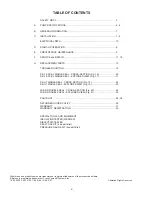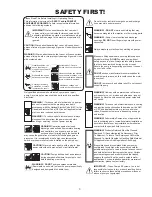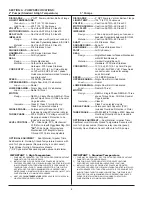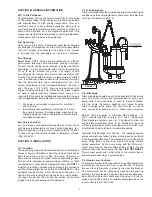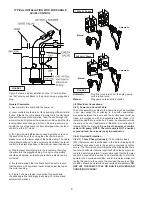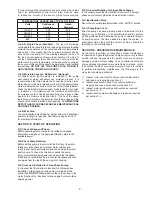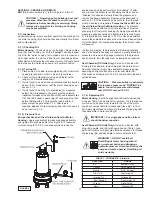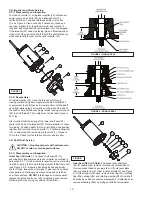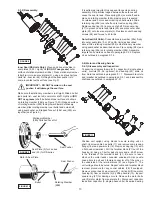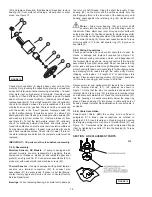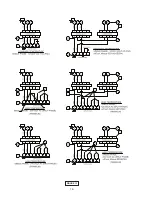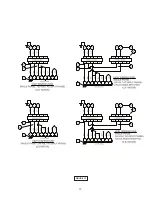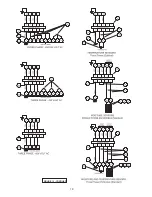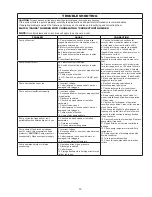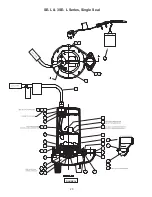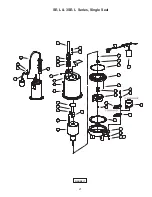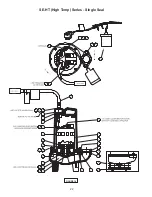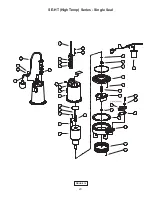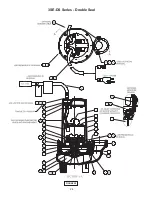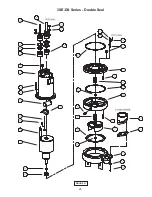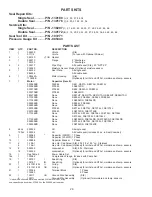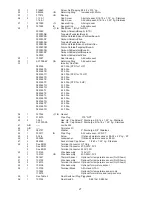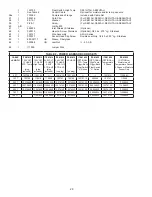
13
F-3.2) Reassembly:
Inner Seal (DS Units Only)-
Clean and oil seal cavities in
seal plates (5, 29). Lightly oil
(DO NOT use grease)
outer
surface of stationary member (28a). Press stationary member
(28a) firmly into inner seal plate (5), using a seal pusher (see
parts list - seal tool kit). Nothing but the seal pusher is to
come in contact with seal face (see Fig 9).
IMPORTANT! - DO NOT hammer on the seal
pusher- it will damage the seal face.
Make sure the stationary member is in straight. Slide a bullet
(see parts list - seal tool kit) over motor shaft. Lightly oil
(DO
NOT use grease)
shaft, bullet and inner surface of bellows
on rotating member (28b) see Figure 10. With lapped surface
of rotating member (28b) facing inward toward stationary
member, slide rotating member over bullet and onto shaft,
using seal pusher, until lapped faces of (28a) and (28b) are
together (see Figure 9).
It is extremely important to keep seal faces clean during
assembly. Dirt particles lodged between these faces will
cause the seal to leak. Place spring (28c) over shaft and in
place on rotating member (28b), making sure it is seated
on retainer and not cocked or resting on bellows tail. Slide
retaining ring (28d) over shaft and let rest on spring (28c).
Replace snap ring (32) in groove of shaft. Set square-ring
(27) in groove on outer seal plate (29) and place outer seal
plate (29) onto inner seal plate (5). Replace socket head cap
screws (64) and torque to 60 in-lbs.
Outer Seal (All Units)-
Press stationary member (28a) firmly
into outer seal plate (5, or 29 on DS Units) as described
above. Slide rotating member (28b) onto stationary member
using seal pusher as described above. Place spring (28c) and
retaining ring (28d) onto rotating member (28b). Assemble
impeller and volute as outlined in paragraph F-2.2. Replace
oil as outlined in paragraph F-1.4.
F-4) Motor and Bearing Service
F-4.1) Disassembly and Inspection:
To examine or replace the motor (7), capacitor (9, single phase
units), controls (55, 56, optional), and bearing (25), drain oil
from motor as outlined in paragraph F-1.1. Disassemble volute
and impeller as outlined in paragraph F-2.1 and disassemble
shaft seal as outlined in paragraph F-3.1.
Position unit upright, using blocks to avoid resting unit on
shaft. Unscrew cable hex bolts (11) and remove compression
flange (16a) and power cord (16). Remove snap ring (19) with
a flat head screwdriver. Pull the terminal block (21) out of the
housing (6) using a T-bolt or pair of pliers and a .25-20 screw
in the threads of the terminal block (21). Be sure to leave
slack on the motor leads connected underneath. Use needle
nose pliers to pull each female connector off of the pins on
the underside of the terminal block (21) see Figure 11. The
unit voltage should be noted. Repeat cable and terminal block
removal procedure for any control cables (56) if equipped.
Remove socket head cap screws (47). Vertically lift the motor
housing (6) from seal plate (5) by lifting handle (13). Inspect
square ring (27) for damage or cuts. Remove the motor bolts
and lift motor stator from seal plate (5). Disconnect capacitor
leads from capacitor (9, single phase units). Examine bearing
Stationary Member
(28A) Polished Face Out
Seal Pusher
Seal Plate (5) for L series
and (29) for DS series
FIGURE 9
Motor & Seal Plate
Bullet
Rotating Member
(28B)
Seal Pusher
FIGURE 10
FIGURE 8
FIGURE 11
Summary of Contents for 104872
Page 16: ...16 FIGURE 13 ...
Page 17: ...17 FIGURE 13 ...
Page 18: ...18 FIGURE 13 CONTIUED ...
Page 20: ...20 FIGURE 16 SE L 3SE L Series Single Seal ...
Page 21: ...21 FIGURE 17 SE L 3SE L Series Single Seal ...
Page 22: ...22 FIGURE 18 SE HT High Temp Series Single Seal ...
Page 23: ...23 FIGURE 19 SE HT High Temp Series Single Seal ...
Page 24: ...24 FIGURE 20 3SE DS Series Double Seal ...
Page 25: ...25 FIGURE 21 3SE DS Series Double Seal ...
Page 29: ...29 Notes ...
Page 30: ...30 Notes ...


